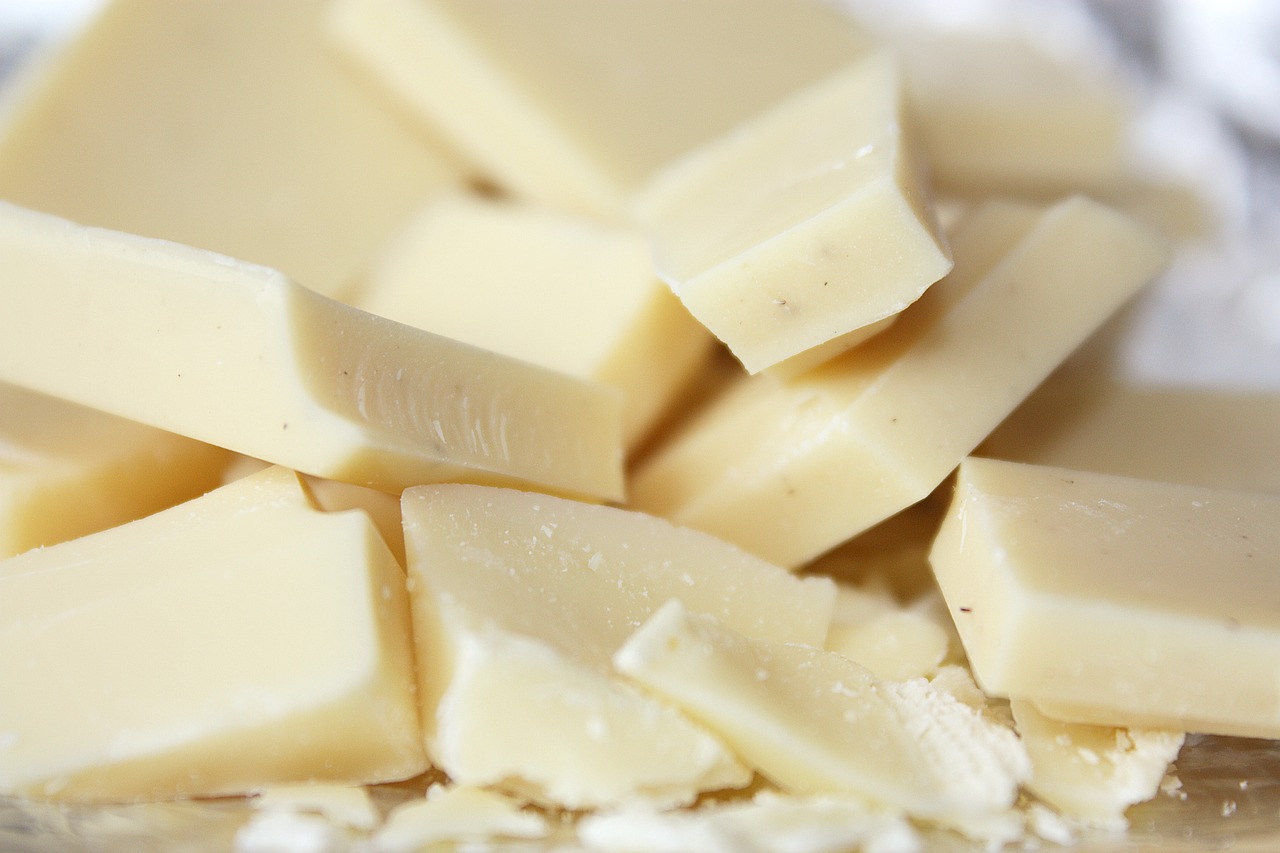White chocolate, often seen as a creamy, sweet indulgence, is unique in the chocolate world because it doesn’t actually contain cocoa solids, which means it lacks the characteristic chocolate flavor found in dark and milk chocolates. Here’s an in-depth look at white chocolate, including its composition, history, uses, and some considerations.
Composition of White Chocolate
- Cocoa Butter: The primary ingredient in white chocolate, cocoa butter is the fat extracted from cocoa beans. It provides a rich, smooth texture and is responsible for the glossy appearance of white chocolate.
- Milk Solids: White chocolate contains milk powder or milk solids, which contribute to its creamy, dairy-rich flavor. This can be whole milk powder or skim milk powder, depending on the formulation.
- Sugar: White chocolate is sweetened with sugar, which balances the richness of the cocoa butter and milk solids.
- Emulsifiers: Ingredients like soy lecithin are used to stabilize the mixture and ensure a smooth, even texture.
History and Development
The development of white chocolate is relatively modern compared to dark and milk chocolates:
- Origins: White chocolate as we know it was first created in the 1930s by the Swiss company Nestlé. The company developed a product called “Nestlé Galak,” which used cocoa butter, milk solids, and sugar.
- Commercialization: Since its introduction, white chocolate has become popular as a sweet treat and ingredient in a variety of recipes. However, its lack of cocoa solids means it’s not considered “chocolate” by some purists and organizations.
Flavor and Texture
White chocolate has a distinct flavor and texture:
- Flavor: It is characterized by its creamy, buttery taste with sweet vanilla notes. Since it lacks cocoa solids, it doesn’t have the characteristic chocolate flavor and is often described as having a rich, milky sweetness.
- Texture: The high cocoa butter content gives white chocolate a smooth, melt-in-your-mouth texture. This makes it ideal for certain culinary applications where a creamy consistency is desired.
Culinary Uses
White chocolate is used in a variety of ways in cooking and baking:
- Baking: White chocolate can be used in baked goods such as cookies, brownies, cakes, and muffins. Its sweetness and creamy texture add a different dimension to these treats.
- Confections: White chocolate is a popular base for confections like truffles, ganaches, and filled chocolates. It pairs well with flavors like fruit, nuts, and spices.
- Sauces and Fillings: White chocolate can be melted to create sauces for drizzling over desserts or used as a filling in pastries and candies.
- Pairing: It pairs well with a variety of flavors, including fruits (such as berries and citrus), spices (like cinnamon and cardamom), and nuts (like almonds and pistachios).
Health Aspects
While white chocolate is enjoyed for its taste, it has some nutritional considerations:
- Nutritional Content: White chocolate contains cocoa butter, milk solids, and sugar but lacks the antioxidants found in cocoa solids. As a result, it doesn’t offer the same health benefits as dark chocolate.
- Sugar and Fat: It is typically higher in sugar and fat compared to dark chocolate. Excessive consumption can contribute to weight gain and other health issues, so it should be eaten in moderation.
Storing and Handling
To maintain the quality of white chocolate:
- Storage: Store white chocolate in a cool, dry place away from direct sunlight and strong odors. The ideal temperature is between 60-70°F (15-21°C).
- Avoid Refrigeration: Like other chocolates, avoid refrigerating white chocolate unless necessary. If refrigeration is required, wrap it tightly to prevent moisture from affecting its texture.
- Melting: When melting white chocolate, do so gently to prevent burning. White chocolate can scorch easily due to its low melting point. Use a double boiler or microwave at low power, stirring frequently.
Ethical Considerations
Ethical sourcing is important for all types of chocolate, including white chocolate:
- Fair Trade: Look for white chocolate products that are Fair Trade-certified to ensure that the cocoa butter used is sourced ethically and that farmers are paid fairly.
- Sustainability: Some brands focus on sustainable practices, including environmentally friendly farming techniques and efforts to improve the lives of cocoa-growing communities.
Conclusion
White chocolate offers a unique taste and texture, distinguishing itself from dark and milk chocolates with its creamy, sweet profile and lack of cocoa solids. While it may not provide the same health benefits as dark chocolate, it remains a versatile ingredient in many culinary applications. Whether used in baking, confections, or as a flavor complement, white chocolate brings a different dimension to the world of sweets.

